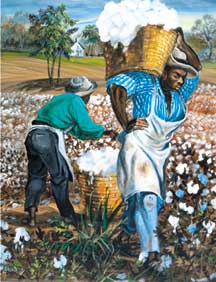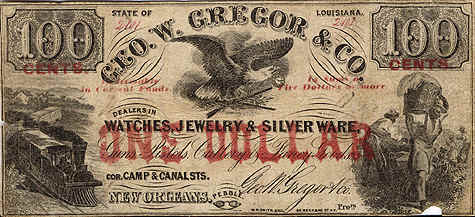If you study currency around the world you'll find that countries tend to depict the images of their economic strength on paper, and coins. In England, the monarchy is pictured on British money as a symbol of power. In Iran, you'll see pictures of agricultural production, and so on. The point is that countries are proud of the resources that drive their economies.
In the early 1800's, American cotton production was an integral part of the economy, and the images of enslaved Africans were shown, primarily, on Confederate and Southern currency. The images of slave labor validate the contribution of African Americans to the economy, overall .
The picture below is graphic artist John W. Jones', "Slave Carrying Cotton", which is shown on 21 different bills of currency. For example, the bill below is from Louisiana. In all, there are 126 such slave images on Confederate and Southern bills.


The images are from Mr. Jones' book, Confederate Currency: The Color of Money. He discovered them, while working as a graphic artist, when one of his customers asked him to enlarge a bank note
from the Confederacy.
The absence of this knowledge shocked and astonished Jones. Later, he decided to bring these images to light as part of his series of paintings on the African American experience. Mr. Jones' work has visualized the fact that while creating wealth for others, Africans were not only unpaid, but unrecognized.
His exhibit, Depictions of Slavery in Confederate and Southern States' Currency, has toured around the country. It has also been featured in such publications as, The New York Times, The Wall Street Journal, Time Magazine, The San Francisco Chronicle, and on CNN.
More info on his book, exhibit, and artistry can be obtained by going to: TheColorofMoney.com - Original Acrylic on Canvas Paintings, by John W. Jones.
In the early 1800's, American cotton production was an integral part of the economy, and the images of enslaved Africans were shown, primarily, on Confederate and Southern currency. The images of slave labor validate the contribution of African Americans to the economy, overall .
The picture below is graphic artist John W. Jones', "Slave Carrying Cotton", which is shown on 21 different bills of currency. For example, the bill below is from Louisiana. In all, there are 126 such slave images on Confederate and Southern bills.


The images are from Mr. Jones' book, Confederate Currency: The Color of Money. He discovered them, while working as a graphic artist, when one of his customers asked him to enlarge a bank note
from the Confederacy.
The absence of this knowledge shocked and astonished Jones. Later, he decided to bring these images to light as part of his series of paintings on the African American experience. Mr. Jones' work has visualized the fact that while creating wealth for others, Africans were not only unpaid, but unrecognized.
His exhibit, Depictions of Slavery in Confederate and Southern States' Currency, has toured around the country. It has also been featured in such publications as, The New York Times, The Wall Street Journal, Time Magazine, The San Francisco Chronicle, and on CNN.
More info on his book, exhibit, and artistry can be obtained by going to: TheColorofMoney.com - Original Acrylic on Canvas Paintings, by John W. Jones.
No comments:
Post a Comment